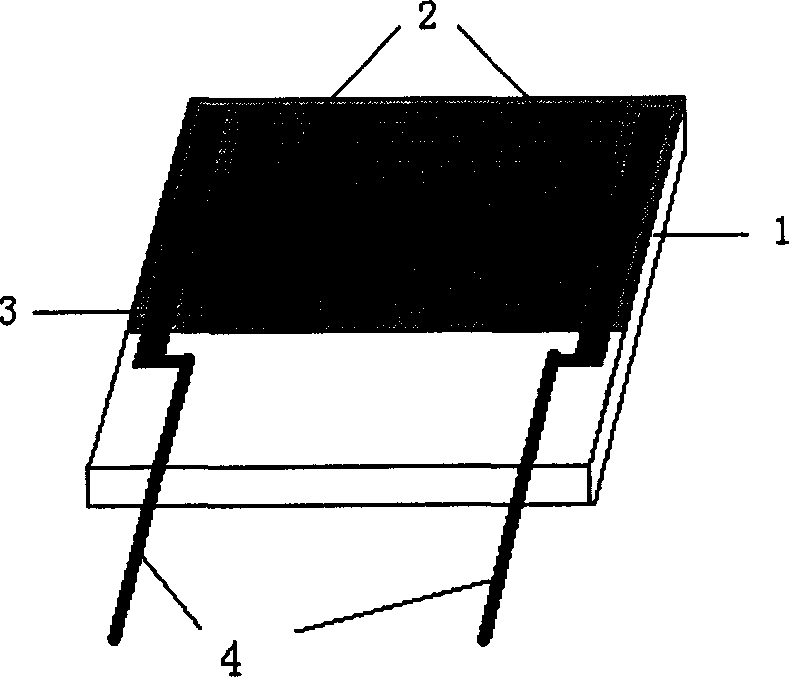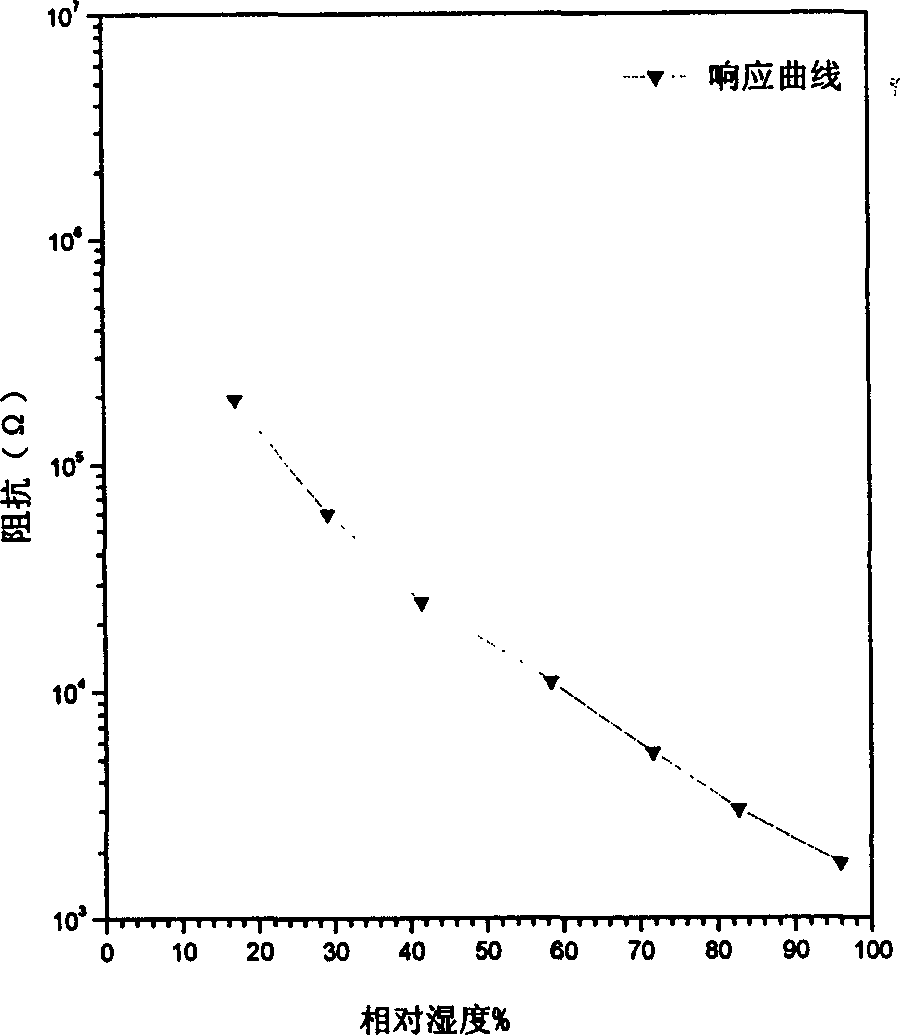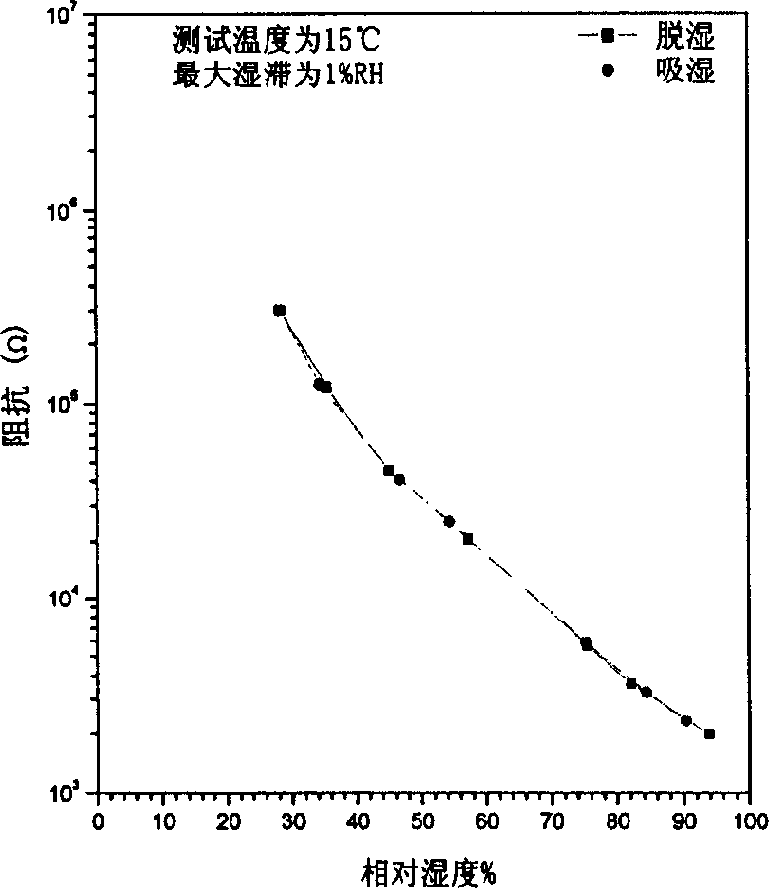Siliceous copolymer resistor type thin film humidity sensitive element and method for making same
A technology of moisture-sensing components and manufacturing methods, which are applied in electrical components, electric solid-state devices, circuits, etc., can solve the problems of poor adhesion between the moisture-sensitive film and the electrode base material, unsatisfactory long-term stability and reliability, and dehumidification. Insufficient response speed, etc., to achieve the effects of fast moisture absorption and dehumidification response speed, improved sensitivity, and low cost
- Summary
- Abstract
- Description
- Claims
- Application Information
AI Technical Summary
Problems solved by technology
Method used
Image
Examples
Embodiment 1
[0023] 1. Electrode cleaning
[0024] Soak and clean the glass-ceramic interdigitated gold electrodes in absolute ethanol and acetone, and dry them for later use
[0025] 2. Preparation of moisture-sensitive film by dip coating and post-treatment
[0026] Use a dipping machine to immerse the glass-ceramic interdigitated gold electrode into a moisture-sensitive solution (20 parts by weight of silicon-containing copolymer-quaternary ammonium salt and siloxane in a molar ratio of 4:1, 100 parts by weight of deionized water), After 4 minutes, pull at a speed of 8 mm / s, take it out and place it in a constant temperature oven, and heat-treat it at 80°C for 15 hours to obtain a moisture-sensitive film;
[0027] 3. Aging treatment
[0028] Put the humidity sensitive element with moisture-sensitive film on the interdigitated gold electrode of glass-ceramics in a constant temperature and humidity box, and apply an AC voltage of 800mv and 1kHz under the environment of 40°C and 60%RH, a...
Embodiment 2
[0030] 1. Electrode cleaning is the same as in Example 1
[0031] 2. Preparation of moisture-sensitive film by dip coating and post-treatment
[0032] Use a dipping machine to immerse the glass-ceramic interdigitated gold electrode into a moisture-sensitive solution (40 parts by weight of silicon-containing copolymer-quaternary ammonium salt and siloxane in a molar ratio of 2:1, 100 parts by weight of deionized water), After 2 minutes, pull at a speed of 6mm / s, take it out and place it in a constant temperature oven, and heat-treat it at 110°C for 8 hours to obtain a moisture-sensitive film;
[0033] 3. Aging treatment
[0034] The moisture sensitive element with moisture-sensitive film on the interdigitated gold electrode of glass-ceramics is aged at 30°C and 90% RH with an AC voltage of 300mv and 1kHz for 30 hours.
[0035] Its moisture-sensitive response characteristics such as figure 2 , hysteresis characteristics such as image 3 , response time characteristics such ...
Embodiment 3
[0037] 1. Electrode cleaning is the same as in Example 1
[0038] 2. Preparation of moisture-sensitive film by dip coating and post-treatment
[0039] Use a dipping machine to immerse the glass-ceramic interdigitated gold electrode into a moisture-sensitive solution (60 parts by weight of silicon-containing copolymer-quaternary ammonium salt and siloxane in a molar ratio of 6:1, 100 parts by weight of deionized water), After 1 minute, pull at a speed of 2 mm / s, take it out and place it in a constant temperature oven, and heat-treat it at 120°C for 5 hours to obtain a moisture-sensitive film;
[0040] 3. Aging treatment
[0041] The moisture sensitive element with moisture-sensitive film on the interdigitated gold electrode of glass-ceramic is aged at 30°C and 80% RH with an AC voltage of 100mv and 1kHz for 50 hours.
PUM
 Login to View More
Login to View More Abstract
Description
Claims
Application Information
 Login to View More
Login to View More - R&D
- Intellectual Property
- Life Sciences
- Materials
- Tech Scout
- Unparalleled Data Quality
- Higher Quality Content
- 60% Fewer Hallucinations
Browse by: Latest US Patents, China's latest patents, Technical Efficacy Thesaurus, Application Domain, Technology Topic, Popular Technical Reports.
© 2025 PatSnap. All rights reserved.Legal|Privacy policy|Modern Slavery Act Transparency Statement|Sitemap|About US| Contact US: help@patsnap.com



